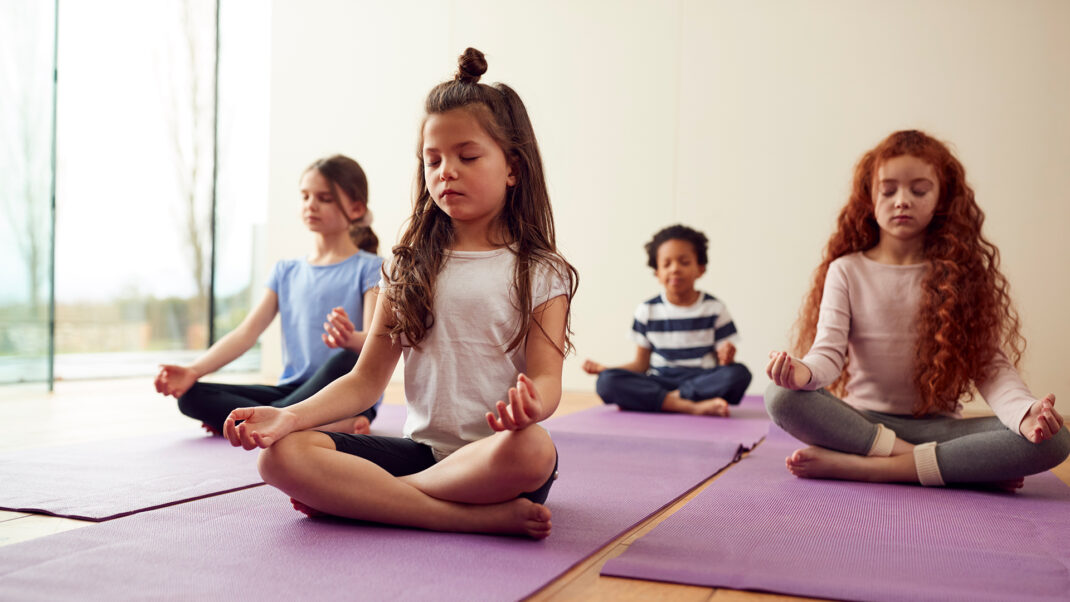Mental Health in Children: Yoga to the Rescue
Yoga can be an effective intervention to improve children's mental well-being.

Poor mental health is detrimental to the development and well-being of children. Can yoga help?
According to the Centers for Disease Control and Prevention (CDC) (2019), in 2019, 13.6% of children aged 5-17 years in the U.S. had received mental health treatment within a 12-month period. The CDC data also submits that older children (aged 12-17 years) are more likely than younger children (aged 5-11 years) to have received any mental health treatment. From a global perspective, the World Health Organization (WHO) (2021) reports that one in seven 10-19-year-olds experiences a mental health disorder, accounting for 13% of the global burden of disease in this age group. The leading causes of disability and illness among adolescence are anxiety, depression and behavioral disorders (WHO 2021). A child’s adolescence, the transitional stage from childhood to adulthood, is a crucial period for developing emotional (i.e., coping and problem solving) and personal habits (i.e., interpersonal skills, regular exercise and positive sleeping habits) important for mental well-being (WHO 2021).
Yoga is a holistic system of physical postures to promote wellbeing, strength, flexibility, and mobility. It incorporates breathing exercises to enhance respiratory function, relaxation poses that focus on reducing tension and stress, and meditation/mindfulness practices to enhance mind-body awareness and emotional control (Butzer et al. 2015). Yoga, developed thousands of years ago, is a recognized form of mind-body medicine (Galantino et al. 2008). The clinical research on yoga indicates that this mind-body intervention will elicit positive mental health benefits for adults. Yoga is not only practiced as a treatment for a range of health conditions, it is practiced as a mode for health maintenance and disease prevention. Promising research now indicates that yoga may also be a beneficial intervention for improving mental health in children (Galantino et al. 2008). Butzer and colleagues (2017) summarize studies showing that yoga may particularly be favorable with regard to improvements in mood and reductions in stress, anxiety and negative emotional states. Galantino and colleagues (2008) confirm that yoga shows great potential as a modality for improving mental health in youth. Importantly, it is critical for fitness pros working with children to be aware of some of the key symptoms in children suffering from some mental health issues. The following sections will discuss:
- Anxiety in children.
- Depression in children.
- Stress in children.
- The mental health benefits of Yoga for youth.
- Designing Yoga-based programs for improving mental health in children.
Anxiety in Children
James-Palmer et al. (2020) clarify that anxiety can be characterized by excessive worry and fear which may manifest itself with disparate troubling thoughts, muscle tension and elevated heart rate, along with other somatic (i.e., bodily) disturbances. These disturbances can negatively impact a child’s school performance. James-Palmer et al. (2020) continue, noting that children with anxiety may withdraw more often from school, as compared to their peers. The researchers explain that anxious children may feel intimated by their teachers and peers, and feel nervous at school. Wehry et al. (2015) highlight data suggesting that anxiety disorders in children will predict a range of psychiatric disorders later in life, including depression, other anxiety disorders and substance abuse. Regarding the outcomes of intervention, James-Palmer and associates (2020) summarize that 70% of yoga intervention studies showed improvements in anxiety in children.
Depression in Children
Symptoms of depression may be present in children that do not have a clinical diagnosis. Therefore, a larger number of children are very likely to contend with symptoms of depression in their daily lives. Depression can manifest itself in children as poor academic performance, perhaps a phobia of school and developmental behavior problems (Aurora et al. 2020). Children with depression can also exhibit bodily ailments and behavioral deficits, and often have extreme sadness and an irritable mood (Aurora et al. 2020). Further, children with depression also exhibit somatic (i.e., bodily) and behavioral deficits, which may be accompanied by excessive sadness and an empty or irritable mood. It should also be noted that children with depression (and anxiety, too) often have substance abuse problems (Aurora et al. 2020). Similar to anxiety outcomes, James-Palmer (2020) show that 40% of yoga intervention studies showed improvements in depression.
Stress in Children
Stress is described as “a state of threatened or perceived as threatened homeostasis.” An increasing number of students, in elementary and secondary education, suffer from stress-related disorders and illnesses (Zisopoulou & Varvogli 2023). In fact, Zisopoulou & Varvogli (2023) submit that approximately 35% of children in America experience stress-related health problems. One of the most common stress-related health problems is recurrent abdominal pain, which is described as pain that inhibits a child from performing normal daily activities, and which occurs at least three times within a period of three months. Other bodily stress-related symptoms include headaches, nausea, chest pain, constipation, arm pain, leg pain and vomiting. Children will need to develop coping skills in order to enjoy future psychological adjustment and well-being. Yoga participation with children has been shown to help relieve stress (from school and home), while also increasing physical activity outside of school (Centeio et al. 2017).
See also: Engaging in Youth Fitness
The Mental Health Benefits of Yoga for Youth
According to the CDC (2023), mental health includes children’s mental, emotional and behavioral well-being. Mental health affects how children feel, think and act. A child’s mental health will contribute to how they handle stress, relate to others, and make healthy choices in daily life (CDC 2023). James-Palmer et al. (2020) cite survey data demonstrating that 80% of children 6-17 years old who were defined as needing mental healthcare did not receive it. This is largely due to parental barriers to mental healthcare that include cultural barriers, cost, transportation and access to mental healthcare providers.
Yoga is increasingly being used in schools for youth social and emotional development, and learning. Many schools have added yoga to their curriculums to address children’s stressors in hopes to positively improve overall student health, fitness, mental health and social relationships. Yoga, is an ancient practice that can enhance well-being through the integration of body and mind with an emphasis on self-realization (James-Palmer et al. 2020). In western psychology, self-realization represents the process by which a person reaches their full potential. Within the practice of yoga are six unique branches that lead to well-being. These branches include the following: meditation, devotion, knowledge, service, ritual and physical postures (which is the most commonly practiced branch of yoga in the western world) (James-Palmer et al. 2020). In addition to physical postures, breathing, meditation and relaxation are commonly utilized in yoga programs for children.
Galatino and colleagues (2008) conducted a systematic review on yoga as an effective intervention to improve cardiorespiratory fitness, physical functioning and behavior, in children and adolescents. The results are striking enough to warrant a callout.
10 Mental Health Benefits of Yoga (Adapted From Galatino et al. 2008)
- enhances processing ability of the central nervous system
- improves motor performance in children
- a promising complementary treatment for children with ADHD already stabilized on medication
- improves working efficiency of children
- improves the overall ability to concentrate and focus
- fosters relaxation and breathing in a very active way, enabling children to channel their energy into goal-driven tasks
- academic learning of children may be further enhanced by memory improvements afforded by yoga
- practice may benefit children with mental challenges by improving their mental ability, along with motor coordination and social skills
- yoga for children with general learning disabilities shows promise
- when combined with relaxation techniques, yoga may increase emotional balance in the long term and reduce fears as well as feelings of helplessness
Designing Yoga-based Programs for Improving Mental Health in Children
In their comprehensive review, James-Palmer et al. (2020) describe the characteristics of yoga interventions (specific for anxiety and depression) for children. The following key characteristics are summarized for fitness professionals who may want to consider designing and administrating yoga-based programs for improving mental health in children.
1. How is the yoga program integrated into the schools?
Most programs went through the school administration in which the program was implemented as an after-school program or had a set designated period. The yoga program may also be presented in physical education periods.
2. What type of yoga program is being offered?
Each study tended to create their own program, with elements taken from common and traditional yoga practices. Mindfulness and movement were common denominators among these programs, through which they utilized key elements of relaxation, self-awareness and grounding (i.e., balanced in mind and body). It was typically found that all programs utilized postures, meditation, breathing, socialization, self-appreciation and relaxation.
3. How many days per week are the sessions offered?
Most yoga interventions provided 1-2 sessions per week.
4. How long are the yoga sessions?
The typical session length of a yoga class is 45 minutes.
5. How is a typical yoga session structured
Generally speaking, the yoga sessions started with 5-10 minutes of breathing exercises, then would transition into the yoga postures and exercises, which would last around 15-30+ minutes. The last part of the session would center around meditation and mindfulness. Some interventions spent the last part of the session by having the kids socialize and discuss with others in a mindful manner.
6. What are the common poses included in the session?
Each study tended to utilize a different set of poses, however all were under the practice of yoga asanas (aka positions). Poses such as tree pose, cobra pose, downward dog, and child’s pose were found amongst several studies. Poses that stretched specific parts of the body were also common.
7. What are the breathing techniques utilized?
Most studies did not specify the actual breathing technique, but were said to include various breathing techniques utilized in yoga programs.
8. What are some of the instructive (i.e., didactic) content covered?
Programs that mentioned didactic content tried to engage kids with each other and to socialize them in an empathetic manner. This included activities that supported affirmations, dancing/games, partner/group activities, cooperation, respect for others and adaptation to the groups. These various programs also taught about the importance of one’s health and body, both physically and mentally. Self-love, respect and empathy were commonly discussed.
9. Who taught the yoga classes?
All studies had a certified yoga instructor teach the class.
10. What type of relaxation was done?
The studied sessions used visualization and meditation, typically towards the end of each session. Children would recline on their backs with a guided meditation from the instructor. The children would focus on their breathing and their imagination.
11. What other noteworthy insights come from the published yoga studies with children?
Some studies encouraged the kids to practice yoga and meditation at home.
See also: Yoga for Optimal Performance
Yoga for Children
Yoga is a multi-factor modality that concurrently treats physical impairments and psychosocial issues such as stress, anxiety and depression. Compelling evidence exists that demonstrates the usefulness of incorporating of yoga to complement existing wellness programs and clinical interventions for children.
References
James-Palmer, A., et al. 2020. Yoga as an Intervention for the Reduction of Symptoms of Anxiety and Depression in Children and Adolescents: A Systematic Review. Frontiers in Pediatrics. 8. doi: 10.3389/fped.2020.00078.
Butzer, B., et al. 2015. Effects of a Classroom-Based Yoga Intervention on Cortisol and Behavior in Second- and Third-Grade Students: A Pilot Study. Journal of Evidence-Based Complementary and Alternative Medicine, 20(1): 41–49.
CDC (Centers for Disease Control and Prevention). 2019. Mental Health Treatment among Children Aged 5 to 17 Years. United States, 2019. Accessed November 16, 2023 https://vizhub.healthdata.org/gbd-results/
Centeio, E.E., et al. 2017. Using Yoga to Reduce Stress and Bullying Behaviors among Urban Youth. Health, 9, 409-424.Galantino, M.L., Balbavy, R., & Quinn, L. 2008. Therapeutic effects of yoga for children: A systematic review of the literature. Pediatric Physical Therapy. 20:66-80.
James-Palmer A, et al. 2020. Yoga as an Intervention for the Reduction of Symptoms of Anxiety and Depression in Children and Adolescents: A Systematic Review. Frontiers in Pediatrics. 8:78. doi: 10.3389/fped.2020.00078
Wehry, A.M., et al. 2015. Assessment and treatment of anxiety disorders in children and adolescents. Current Psychiatry Reports, 17(7): 591. doi:10.1007/s11920-015-0591-z
WHO (World Health Organization). 2021. Mental health of adolescents. Accessed Nov. 16, 2023: https://www.who.int/news-room/fact-sheets/detail/adolescent-mental-health
Zisopoulou, T. & Varvogli, L. 2023. Stress management methods in children and adolescents: Past, present, and future. Hormone Research in Pediatrics, 96, 97-107.
Len Kravitz, PhD
Len Kravitz, PhD is a professor and program coordinator of exercise science at the University of New Mexico where he recently received the Presidential Award of Distinction and the Outstanding Teacher of the Year award. In addition to being a 2016 inductee into the National Fitness Hall of Fame, Dr. Kravitz was awarded the Fitness Educator of the Year by the American Council on Exercise. Just recently, ACSM honored him with writing the 'Paper of the Year' for the ACSM Health and Fitness Journal.
Rowan Tuller
Rowan Tuller is a senior at San Marcos High School in California. His professional goal is to work in the field of psychology/education for elementary age kids because of his passion for holistically helping kids thrive both physically and mentally.






